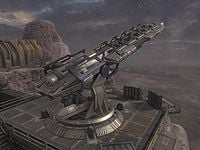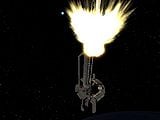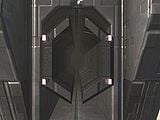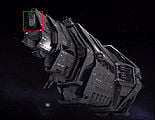Magnetic Accelerator Cannon: Difference between revisions
From Halopedia, the Halo wiki
No edit summary Tag: Mobile edit |
(Considering how contentious and up to interpretation this topic is, it's best not to list any definite figures.) |
||
| Line 80: | Line 80: | ||
==="Super" Magnetic Accelerator Cannon=== | ==="Super" Magnetic Accelerator Cannon=== | ||
[[File:H2A - ODP.jpg|250px|thumb|An orbital defense platform ([[Cairo Station|ODA-142: Cairo Station]]) armed with a "Super" Magnetic Accelerator Cannon.]] | [[File:H2A - ODP.jpg|250px|thumb|An orbital defense platform ([[Cairo Station|ODA-142: Cairo Station]]) armed with a "Super" Magnetic Accelerator Cannon.]] | ||
UNSC [[orbital defense platform]]s, {{Class|Punic|supercarrier}}s and the {{UNSCShip|Infinity}} mount larger and more powerful versions of the standard Magnetic Accelerator Cannon, nicknamed the ''"Super"'' MAC or the ''"big stick"''. An orbital defense platform's cannon is {{convert|802.2|m|ft}} long,<ref name="visual"/> with the platforms present in orbit of Reach, which were among the most powerful ever built,<ref name=CanonFodder70>[https://www.halowaypoint.com/en-us/community/blog-posts/canon-fodder-looking-glassed '''Waypoint''': ''Canon Fodder - Lookin Glassed'']</ref> being capable of firing a 3,000-ton ferric-tungsten rounds at .04''c'' or 4% of the speed of light, impacting with a massive amount of | UNSC [[orbital defense platform]]s, {{Class|Punic|supercarrier}}s and the {{UNSCShip|Infinity}} mount larger and more powerful versions of the standard Magnetic Accelerator Cannon, nicknamed the ''"Super"'' MAC or the ''"big stick"''. An orbital defense platform's cannon is {{convert|802.2|m|ft}} long,<ref name="visual"/> with the platforms present in orbit of Reach, which were among the most powerful ever built,<ref name=CanonFodder70>[https://www.halowaypoint.com/en-us/community/blog-posts/canon-fodder-looking-glassed '''Waypoint''': ''Canon Fodder - Lookin Glassed'']</ref> being capable of firing a 3,000-ton ferric-tungsten rounds at .04''c'' or 4% of the speed of light, impacting with a massive amount of kinetic energy.<ref name="for283"/><ref name="big MAC yield" group="note">''The Halo Encyclopedia'' claims that a Super MAC slug is fired at .5''c'' (50% the speed of light), and that its explosive yield is around 9.98 teratons. This would result in an explosion with around 184,815 more energy than the aforementioned Tsar Bomba, or roughly one tenth of the energy released by the Chicxulub impactor which wiped out the dinosaurs 65 million years ago.</ref> Most UNSC and Covenant vessels are destroyed by this weapon, with shielded Covenant destroyers being shattered into "a million fragments" upon impact.<ref>'''Halo: The Fall of Reach''', ''page 297'' (2001 edition)</ref> However, these guns, even with assistance from the UNSC Home Fleet, were not powerful enough to pierce the shields of the [[Ur-Didact]]'s flagship, ''[[Mantle's Approach]]''. Only the {{UNSCShip|Infinity}}'s MAC guns managed to pierce ''Mantle's Approach's'' shields at a closer range and cause some damage and even then only after [[John-117]] managed to disable some of the ship's point-defense guns using an [[F-41 Broadsword]].<ref name="midnight"/> | ||
By receiving power from [[Orbital defense generator|ground-based power plants]], orbital defense platforms could achieve recharge and reload times as short as five seconds.<ref name="Cairo"/><ref name="for283"/> | By receiving power from [[Orbital defense generator|ground-based power plants]], orbital defense platforms could achieve recharge and reload times as short as five seconds.<ref name="Cairo"/><ref name="for283"/> | ||
Revision as of 04:52, March 11, 2019
The Magnetic Accelerator Cannon (MAC), also known as the Mass Accelerator Cannon,[1][2] is a weapon system employed by the United Nations Space Command on its warships and orbital defense platforms. Essentially large coilguns, MACs serve as the primary armament of UNSC Navy warships and weapon platforms.
Overview
Operational design
The theory behind the operation of a Magnetic Accelerator Cannon is the same as that of a coilgun. The system is a linear motor consisting of a series of magnetic coils which accelerate a metal projectile through a barrel up to high velocity. This technology is not to be confused with that of a railgun, in which a projectile is electromagnetically accelerated between two conducting rails.
Firing operation
The firing process uses electromagnetism to fire a metal slug at high velocity. An extremely large amount of current is put through the first solenoid, (coil of conducting wire), which creates a strong magnetic field that attracts the slug. As the slug passes into the solenoid, the solenoid is quickly turned off and the second solenoid, which is closer to the muzzle, turns on, which attracts the now higher-velocity metal slug just like the first solenoid, and the process is carried on.
A shipboard MAC draws power from the ship's reactor and requires a charge of the weapon's magnetic coils in order to be fired. The time it takes to bring the MAC's systems to full charge on a UNSC vessel is the deciding factor during in-combat use. Thus, while a vessel may not run out of ammunition for a long time, (depending on the size/weight of the slugs and the capacity of the ship), a commanding officer has to carefully analyze the situation of a battle and use his shots strategically. The weapon could be fired even when not at full charge, but the velocity of the projectile will be greatly diminished.
Orbital defense platforms have the same firing process, though they launch much more massive projectiles, (3,000 tons), with greater frequency. At the moment a slug leaves an ODP-mounted MAC's muzzle, a pair of thrusters on the bottom side of the station fire for a few of seconds to counteract the acceleration imparted to the station.[3]
Ammunition
Payloads used in the Magnetic Accelerator Cannon weapon delivery system alternates with the platform which the weapon is hosted; warship models tend to use ferric, ferrous, or depleted uranium cores whereas orbital platform models commonly use ferric tungsten rounds.[4]
The standard frigate-based MAC fires a 600-ton slug around 30 kilometers per second. The high muzzle velocity provides the slug the kinetic energy and momentum necessary to damage a target and partially mitigates its unguided nature and its lack of maneuverability.[5] A "Super MAC" mounted on one of the Reach orbital defense platforms[6] was capable of firing a 3,000-ton slug at nearly .04c, or around 12,000 kilometers per second.[4]
Aiming
The size of a Magnetic Accelerator Cannon is such that it is normally an integral component of a warship's structure. Orbital defense platforms are built around the massive weapon. A dedicated targeting computer or an AI is typically required to aim or fire the cannon,[citation needed] as the projectiles are unguided.
Types
There are numerous variations of the MAC technology, grouped under several "Mark"-based designations. MAC systems are also sometimes roughly divided between "heavy coil" and "light coil" guns.[7][8] All known frigate classes carry one MAC system, whereas the standard destroyer[9] and the Marathon-class heavy cruiser carry two MACs.[10] The Navy's post-war flagship, UNSC Infinity, is armed with four Magnetic Accelerator Cannons.[7]
Mark II
The Mark II is a MAC version that uses light coils.
- Mark II, Light Coil - 56A2D4 MAC: The 56A2D4 MAC is a variant that was on the UNSC In Amber Clad, in where it is fitted on the lower boom, with the upper boom having fire control systems and pulsed power storage for the MAC.[11][12] It was also fitted onto the UNSC Pillar of Autumn after it was refitted.[13]
- Mark II, Light Coil - 83B6R3 MAC: The 83B6R3 MAC is a variant that was on the UNSC Forward Unto Dawn.[14]
Mark IV
The Mark IV is a MAC version that uses heavy coils.
- Mark IV, Heavy Coil - 94B1E6 MAC: The 94B1E6 MAC is a variant that was on the Strident-class heavy frigate.[15][16]
Mark V
The Mark V MAC is a MAC version that could be fitted onto orbital stations. The projectiles fired by the Mark V were massive.[17]
Mark IX
The Mark IX is a MAC version that uses heavy coils.
- Mark IX, Heavy Coil - 45J3D3 MAC: The 45J3D3 MAC is a variant that was on the Autumn-class heavy cruiser[18]
Series 8
The Series 8 is a MAC version on the UNSC Infinity. Four of these are fitted on the Infinity.
- CR-03 Series 8 MAC: The CR-03 Series 8 MAC, also known as the CR-03S8 MAC,[19] was the first version of MACs installed on the Infinity.
- CR-03B Series 8 MAC: The CR-03B Series 8 MAC was the version put onto the Infinity after it was retrofitted in 2558.[20]
Unknown
The following MAC version currently have an unknown Mark or series.
- Light Coil - 56A2F9 MAC: The 56A2F9 MAC is a rapid fire variant of the Mark II, Light Coil - 56A2D4 MAC. It is fitted on the Epoch-class heavy carrier.[21]
- 14B11R2 MAC Battery: The 14B11R2 MAC Battery is a variant that is a spinal-mounted, twin-linked, 1170mm/647mm high-velocity coilgun. It is fitted on the Halberd-class destroyer.[22]
- 14D4A1 MAC: The 14D4A1 MAC is a variant that is on the Moncton-class orbital weapon platform.[23]
Internal workings of the 14D4A1 MAC on Cairo Station.
- 20DA1C2 MAC: The 20DA1C2 MAC is a variant on the Gladius-class heavy corvette.[24]
- 22B6R3 MAC Battery: The 22B6R3 MAC Battery is a variant that is a 530cm multi-payload coilgun. Three of these are filled on the UNSC Spirit of Fire.[25]
Ship board fitting
Frigates and destroyers

A standard frigate-mounted MAC averages at 183 metres (600 ft).[2] It can fire a 600-ton ferric-tungsten projectile with a depleted uranium core at 30,000 meters per second, and takes several minutes to recharge to full capacity between shots.[5] The large amount of energy needed to fire the weapon is particularly onerous on a warship, and the extended recharge time is a significant factor in combat against Covenant warships. As a result, MAC rounds are often fired at significantly below their maximum potential velocity by an order of magnitude or more. This results in the impacts being much weaker, but the MACs can be fired far faster and such firepower is still sufficient to destroy the shields of most Covenant warships after a few hits.[note 1] The standard Magnetic Accelerator Cannon is sufficient to destroy any human vessel or severely damage an unshielded Covenant vessel.[note 2]
Specialized and modified versions
The standard MAC can be enhanced with booster capacitors which allow the weapon to be fired three times per charge rather than once per charge. This improved technology was only known to be implemented with the UNSC Pillar of Autumn prior to the Fall of Reach.[26] The modified weapon, known as the Mark II, Light Coil - 56A2D4/MAC,[27] charged faster than the standard version, though this is likely due to the Pillar of Autumn's advanced reactors.[26] Also exclusive to the Pillar of Autumn along with the modified MAC were newer and lighter MAC rounds that had less dense ferrous core, but a harder outer layer of tungsten carbide.[26]
"Super" Magnetic Accelerator Cannon
UNSC orbital defense platforms, Punic-class supercarriers and the UNSC Infinity mount larger and more powerful versions of the standard Magnetic Accelerator Cannon, nicknamed the "Super" MAC or the "big stick". An orbital defense platform's cannon is 802.2 metres (2,632 ft) long,[2] with the platforms present in orbit of Reach, which were among the most powerful ever built,[6] being capable of firing a 3,000-ton ferric-tungsten rounds at .04c or 4% of the speed of light, impacting with a massive amount of kinetic energy.[4][note 3] Most UNSC and Covenant vessels are destroyed by this weapon, with shielded Covenant destroyers being shattered into "a million fragments" upon impact.[28] However, these guns, even with assistance from the UNSC Home Fleet, were not powerful enough to pierce the shields of the Ur-Didact's flagship, Mantle's Approach. Only the UNSC Infinity's MAC guns managed to pierce Mantle's Approach's shields at a closer range and cause some damage and even then only after John-117 managed to disable some of the ship's point-defense guns using an F-41 Broadsword.[29]
By receiving power from ground-based power plants, orbital defense platforms could achieve recharge and reload times as short as five seconds.[3][4]
The first in her own class, UNSC Infinity is equipped with four Super MACs, the CR-03, Series-8 Magnetic Accelerator Cannons.[7][30] In addition to standard MAC rounds, the CR-03S8 is capable of firing various subcaliber rounds, cargo packages, and autonomous kill vehicles with specialized payloads.[30] Two of these nearly 27m-bore coilguns were powerful enough to breach the Mantle's Approach's powerful shields and hull, allowing the Master Chief to enter the ship. However, the Infinity had to get within relatively close range and needed John-117 to disable some of the Mantle's Approach's point-defense guns to take the shot. Even then, Infinity's shot caused relatively minor damage that was quickly sealed by the powerful Forerunner ship. Notably however, these MAC guns were the only weapons to breach the Didact's shields at all with even the MAC guns of Earth's orbital defense platforms failing to do any damage.[29]
Small Magnetic Accelerator Cannons
Mini-MAC
- Main article: M510 Mammoth
A UNSC "Mammoth" terrestrial siegework platform mounts a Mark 2457/35cm HRG;[31] a miniature, mobile version of the standard Magnetic Accelerator Cannon, colloquially referred to as a "Mini-MAC".[32] It is designed to destroy terrestrial and suborbital fortifications and warships.[33] G81 Condor Gunships are also equipped with a Mini-MAC, for use against hard targets.[34]
"Onager"
The Mark 2488 Magnetic Accelerator Cannon, informally known as the Onager, is a relatively small Magnetic Accelerator Cannon used for static defense. A manned version was used to defend the Pillar of Autumn on Reach.[35] The Mark 2488 fires a 15cm round with up to 1.1 gigajoules (0.25 tons) of kinetic energy. It is 32.6 meters long,[36] making a standard frigate-mounted MAC 5.6 times larger by length and roughly 177 times larger by volume, assuming similar dimensions. After the war, a new automated variant, the Mark 2551, was used by the UNSC Infinity on Requiem. Ivanoff Station was also equipped with several automated Mark 2551 Onagers.[37] The setback of the new Mark 2551 however, it cannot be operated manually unlike Mark 2488. When the defense network is offline, the Mark 2551 MAC was rendered inoperable like how UNSC Infinity MAC network is offline while Mark 2488 can still manually operated without reliance on defense network.
Related technologies
M68 Gauss Cannon
- Main article: M68 Gauss Cannon
The M68 Gauss Cannon is a weapon mounted on the M12G1 Light Anti-Armor Vehicle as well as on stationary turrets. It utilizes the same coilgun technology used in MAC, but on a smaller scale.
M92 Principle Gauss Cannon
- Main article: M92 Principle Gauss Cannon
The M92 Principle Gauss Cannon is a weapon system of similar MAC mechanics that runs along the length of the Open Frame 92/Extra-Vehicular Activity.
M99 Stanchion Gauss Rifle
- Main article: Model 99 Special Application Scoped Rifle
The M99 is a man portable anti-matériel and anti-personnel special application weapon using 5.4mm/.21 caliber rounds. Like the M68 Gauss Cannon, it utilizes the same coilgun technology as a MAC, only on an even smaller scale. Though smaller than conventional ammunition, these rounds are accelerated to speeds fast enough to travel long distances with almost no change in trajectory, punch through any obstructing materials, hit their target, and still retain significant kinetic energy.
Mass drivers
- Main article: Mass driver
The mass driver is an orbital launch assembly designed to propel low-weight payloads into orbit, otherwise known as orbital lifting, or to deliver them across a planetary system. The operating principle of the mass driver is essentially the same as that of the Magnetic Accelerator Cannon: it is a large coilgun that magnetically accelerates a package consisting of a magnetizable holder containing a payload.
While not a purpose-built weapon like the Magnetic Accelerator Cannon, these platforms are still potent weapons of opportunity. While never formally incorporated as a weapon, mass drivers have been used at as defensive magnetic accelerator weapons at Harvest, the Rubble, and Reach.
Gameplay
Halo Wars
- "Use the Spirit of Fire's awesome Mass Accelerator Cannon to incinerate enemy troops."
- — In-game description.
In Halo Wars, the MAC Blast ability allows the player to use the UNSC Spirit of Fire's point-defense MACs for pinpoint orbital bombardment. It is mainly used as a support weapon to help the UNSC penetrate heavy Covenant defenses and Covenant bases, and is a potent weapon against Scarabs.
In Skirmish and multiplayer, the MAC Blast can only be used if Captain James Cutter is selected as the player's leader character. In the campaign, the MAC Blast is available in several missions, most notably Dome of Light, during which the player is granted access to forty rapid-fire MAC rounds to destroy a Covenant base that was located under a Covenant energy shield dome until part of the dome was overloaded using Rhinos.
Halo Wars 2
In Halo Wars 2, the MAC Blast has been upgraded by Ellen Anders and Isabel into MAC Blast EMP, which is very effective against all mechanical units. The EMP MAC is only available during the campaign mission "The Cartographer", where it is used to fire on a swarm of Aggressor Sentinels defending a Forerunner conduit. In Multiplayer and Blitz Mode, the MAC Blast is exclusive to Isabel and Sergeant Johnson. Isabel uses standard MAC rounds, while Johnson uses EMP rounds.
Changes from Halo Wars to Halo Wars 2
- MAC rounds can no longer can be upgraded via the Armory.
- Leader Points now can be used to upgrade MAC damage.
Gallery
An orbital defense platform above Reach firing its main cannon.
Nassau Station firing its MAC.
Cairo Station firing its "Super" MAC.
- Navesota.jpg
A frontal view of a Charon-class light frigate's MAC.
- Storm3.jpg
MAC slugs impacting the Forerunner Dreadnought, to little effect.
The UNSC Grafton firing its MAC at Spire One.
The muzzle of the UNSC Pillar of Autumn's MAC.
The UNSC Infinity fires her forward MAC cannons at the Mantle's Approach.
The effect of a MAC round fired from an orbital defense platform on an SDV-class heavy corvette.
- HaloWars-MACBlast-Reticule.jpg
The aiming reticle of the MAC gun in Halo Wars.
- MAC - Bombardment.jpg
A MAC round impacting the surface of Harvest.
UNSC Commonwealth firing her MAC.
List of appearances
- Halo: The Fall of Reach (First appearance)
- Halo: Combat Evolved
- Halo: The Flood
- Halo: First Strike
- Halo 2
- Halo: Ghosts of Onyx
- Halo: Uprising
- Halo 3
- Halo: Contact Harvest
- Halo: The Cole Protocol
- Halo Legends
- Halo: Evolutions - Essential Tales of the Halo Universe
- Halo: Reach
- Halo: Combat Evolved Anniversary
- Halo: The Thursday War
- Halo 4
- Halo: Escalation
- Halo 2: Anniversary
- Halo: Fleet Battles
- Halo: The Fall of Reach - The Animated Series
- Halo 5: Guardians
- Halo: Shadow of Intent (Mentioned only)
- Halo Mythos
- Halo: Smoke and Shadow (Mentioned only)
- Halo Wars 2
- Halo: Envoy (Mentioned only)
Notes
- ^ In every single space battle scene in the novels, including Halo: The Fall of Reach and Halo: Ghosts of Onyx, MAC slugs are described as cleanly penetrating from one end of Covenant ships and out the other, as well as punching holes in whatever they hit. This would be impossible if the slugs were actually going at 30 kilometers per second on every occasion, as past around 1.7 km/s, the tungsten slugs would create hypervelocityimpacts. Therefore, the coilguns must be "dialed down", trading pure power and velocity for refire rate (as a point of comparison, a 600 ton object traveling at 1 km/s would impact with the force of 65 tons of TNT). This matches the depiction of MACs in the games, where they have a refire rate of only a few seconds and muzzle velocities of only a few kilometers per second at most (as in the last cutscene of Cairo Station in Halo 2: Anniversary). It also fits the velocity of the MAC slugs in Halo: The Fall of Reach - The Animated Series, and the description of a MAC propelling slugs to supersonic (between 340 m/s and 1.7 km/s) velocities on pg. 264 of Halo: First Strike.
- ^ The Halo Encyclopedia erroneously states that a typical shipboard MAC slug is fired at .4c (40% the speed of light), which would probably cause the projectile to be atomized by its own acceleration. The weapon's explosive yield is listed as equivalent to 1.17 teratons of TNT. This would release an average of 21,667 times more energy than Tsar Bomba, the largest nuclear device in history, which is generally agreed to have released between 50 and 58 megatons (210 to 240 petajoules) of TNT-equivalent energy.
- ^ The Halo Encyclopedia claims that a Super MAC slug is fired at .5c (50% the speed of light), and that its explosive yield is around 9.98 teratons. This would result in an explosion with around 184,815 more energy than the aforementioned Tsar Bomba, or roughly one tenth of the energy released by the Chicxulub impactor which wiped out the dinosaurs 65 million years ago.
Sources
- ^ Halo: Contact Harvest, Chapter 7, page 119
- ^ a b c Halo: The Essential Visual Guide, page 114
- ^ a b Halo 2, campaign level Cairo Station
- ^ a b c d Halo: The Fall of Reach, page 283
- ^ a b Halo: The Fall of Reach, page 108 (2001 edition); page 130 (2010 edition)
- ^ a b Waypoint: Canon Fodder - Lookin Glassed
- ^ a b c Waypoint: The Halo Bulletin: 10.10.12
- ^ Halo 4: The Essential Visual Guide, page 191
- ^ Halo: The Fall of Reach, page 139
- ^ Halo Encyclopedia, page 251
- ^ Halo Waypoint: UNSC In Amber Clad
- ^ Halo: Warfleet, p. 36-37
- ^ Halo: Warfleet, p. 25
- ^ Halo 4: The Essential Visual Guide, page 192
- ^ Halo Waypoint: UNSC Frigate
- ^ Halo 4: The Essential Visual Guide, page 192
- ^ Halo: The Fall of Reach, Chapter 24; page 217(2001 paperback), page 249(2010 paperback)
- ^ Halo 4: The Essential Visual Guide, p. 191
- ^ Halo Mythos, page 133
- ^ Halo: Warfleet, pages 42-43
- ^ Halo: Warfleet, pages 40
- ^ Halo Mythos, pages 82-83
- ^ Halo: Warfleet, pages 30
- ^ Halo: Warfleet, pages 19
- ^ Halo Mythos, page 71
- ^ a b c Halo: The Fall of Reach, page 275
- ^ Halo Waypoint: Pillar of Autumn
- ^ Halo: The Fall of Reach, page 297 (2001 edition)
- ^ a b Halo 4, campaign level Midnight
- ^ a b Halo Mythos, page 133
- ^ Halo 4: The Essential Visual Guide, page 115
- ^ Halo 4, campaign level Reclaimer
- ^ Halo 4 Interactive Guide
- ^ Halo Waypoint - Canon Fodder: The Art of War(s)
- ^ Halo: Reach, campaign level The Pillar of Autumn
- ^ Halo 4: The Essential Visual Guide, page 75
- ^ Halo 4, campaign level Composer
















